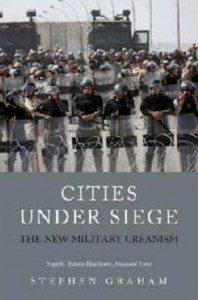Military Urbanism?
‘Cities Under Siege: The New Military Urbanism’ by Stephen Graham; Verso, 2011. 402pp
Reviewed by Austin Williams | 18 December 2012
Urban transformation has often been considered to be a virtue, but some view it differently; as a source of instability and conflict.  The United Nations calls cities “dynamic centres of creativity, commerce and culture” but adds that they are “better known for their chaos and grime”.
The United Nations calls cities “dynamic centres of creativity, commerce and culture” but adds that they are “better known for their chaos and grime”.
Nowadays, the negative viewpoint seems to be in the ascendant with rapid urbanisation regularly seen through the contemporary prism of social, political and ecological concerns: over-population, erosion of traditional values and the dangers of pollution, to name but a few. Within the West, as cities grow, it seems that with them grows a heightened sense of social unrest, violence, urban blight and a community breakdown.
This book explores the consequent mechanisms used to contain those perceived negative tensions. It begins with an exploration of the terminology that has entered everyday conversation, moves on to the various techniques employed to quell instability, followed by global case studies and ending with his own oppositional cri-de-guerre. Graham looks at the fact that many interventions – from gated communities to ‘wars on terror’ – actually perpetuate rather than placate our fears and correctly advocates free “associational citizenship” as opposed to the formation of quasi-juridical private individual. This is an important liberal argument and one which those proponents of “protecting the individual”, terror-proofing, surveillance or “forting up” should understand.
Cities Under Siege looks at how the language of war permeates metropolitan politics; how the fear of anti-social elements is used by authorities to pacify protest; and how military doctrine is re-emerging into urban discourse and practice. For this, it is worth reading, even though it is not the most readable of books. However, here are some concerns:
Firstly, it is based on a series of previously published articles, going as far back as 2005. The conclusion dates from 2008 and four years is a long time in politics, especially since the start of the (forthcoming?) recession has had a significant impact on this narrative. To read that Republicans “widely depicted Democratic presidential candidate, Barack Obama, as a lurking ally of that ultimate terrorist foe, Osama bin Laden” rings a little oddly in the circumstances.
Secondly, from the famous ring-of-steel in the city of London that followed the IRA bomb attacks in the 1990s, to the proliferation of nearly 2 million CCTV cameras today, it has long been recognized that urban Britain is heavily monitored by the state. But militarized? Isn’t this a bit over the top?
Thirdly, it is true that, in many countries, authoritarian states still bulldoze shanties, biometric information is now regularly mined from the public without request (and without protest) and wars still take place in countries about which we know little. States detain, deport and kill people. However, to claim ‘urbicide’, (political violence designed to erase or kill cities) is a fetishistic architectural interpretation of reality. From Hiroshima to Troy, military tactics have included physical destruction, but it seems somewhat perverse to take it as a personal affront to architecture.
Finally, Graham occasionally lapses into bilious rants. Here’s one example, which needs to be quoted at length: “With the easing of state monopolies on violence and the proliferation of acquisitive private military and mercenary corporations, the brutal ‘urbicidal’ violence and dispossession that so often helps bolster the parasitic aspects of Western city economies, as well as feeding corporate capitalism, is more apparent than ever”. For this reviewer, these Castro-esque position statements muddy some of the intelligent observations that run through the book.
In some respects this book is the flipside of Stephen Duncombe’s ‘Dream: Re-imagining Progressive Politics in an Age of Fantasy’. Where Duncombe claimed to invent a progressive narrative for society, so Graham reveals the existence and origins of the negative imagineering: those intangible power relationships that give society cohesion. Both want to rediscover a positive challenge to the debilitating paranoia within society, and both have needed to invent clear foes against which to mobilise. Unfortunately, both have invented a “rightist” plot to give a framework for their ambitions. But not only does this concentration on neo-liberal world domination seem dated, it also sounds ironic given that most states, and particularly the Conservative ones, appear to be hopelessly rudderless at the moment.
In fact, the Manifesto Club, a small left-wing action group based in London has written many reports detailing what they call the ‘Hyper-Regulation of Public Space’. These are the commonplaces of intrusive intervention in civic space about which we have become blasé. So whereas Graham suggests that this is some kind of right-wing, military authoritarian attack on implicitly leftist liberalism, the insidious colonization of public space has regularly come from the liberal left demanding onerous restrictions on odious right-wing groups. Tragically, it is now considered illiberal, naïve or plain stupid to defend freedom, without first listing the caveats. Graham seems unable to grasp this structural collapse in political ideology and seeks to impose his own fantasy interpretation. However, just like Castro’s memoirs, his thesis reads – in part – as if it comes from another era.
——–
This review first appeared in The Architectural Review
Austin Williams is lecturer in architecture at XJTLU in Suzhou and director of the Future Cities Project.






